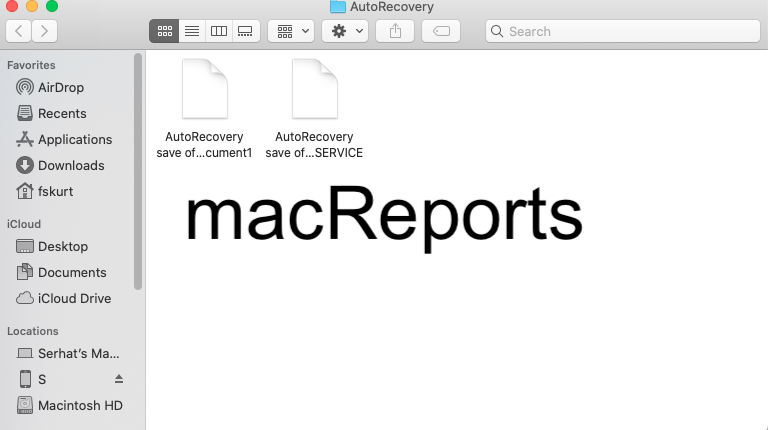/001-microsoft-word-files-wont-open-3540218-fd30da3922414149af0dd0b282e12567.jpg)
 How to Recover Unsaved Microsoft Word Documents on Mac OS
How to Recover Unsaved Microsoft Word Documents on Mac OSRecover the Word doc from the AutoRecovery folder
Launch it to start Mac Word files recovery. Please select Documents; toggle the switch to On. Select the partition/disk that contains the unsaved Word document and click on the Scan button to search for lost Word documents. Wait for the scan and check all the Word documents you want to recover from Mac. Wait for Word application to open the recovered Word document and click 'Save As' to save it as a new document. How to Open and Repair a Corrupt Word File on Mac. Applies to: Fix and repair a corrupt Word 2016/2019/2013 and even older versions of Word file on Mac. Best for: All levels of Word and Mac users.
- Part 3: Recover Word on Mac with Auto Recovery in Microsoft Word. The Word for Mac features an AutoRecovery option. It is enabled by default. It will automatically save a copy of an open Word document every 10 minutes.
- There are three basic steps to recover deleted, corrupted or lost word file on Mac. If you launch the Word recovery Mac tool, then by default all files are checked. If you want to recover word files on Mac, then you just only keep the 'Documents' is selected and click 'Start' button.
- Firstly, open the MS Word application on your Mac and try opening the file. If you are lucky, you would be able to open the file without the Word application crashing. Quickly, go to the File menu and click on the 'Save As' option.
Word for Mac has a built-in autosave feature called AutoRecover which is switched on by default. This means that Word is quietly saving the document you are working on without you needing to manually tell the software to do so.

For this feature to function properly you'll need to initially save the document with a name, then Word will make incremental saves every ten minutes.
However, if the document was lost because your computer or software shut down unexpectedly then you should be prompted with a recovered file when you relaunch Word, even if you hadn't saved it yet. In that case you still might be able to find a version of it in the AutoRecovery folder. Pokemon rom hacks no.
The way this works depends on the version of Word for Mac you are using. We'll look at each separately below.
How to find the AutoRecovery folder in Word 2016
Here's how to find AutoRecover in Word 2016:
- In Word 2016, the AutoRecovery folder is buried deep in the system and requires your Mac to display hidden files, so the first step is to reveal these secret folders, to do so we recommend following our advice at the link below, although the key combination to use is cmd + shift + . (full stop). Read: HOW TO ACCESS THE HIDDEN LIBRARY FOLDER ON MAC
- With this done you'll need to open Finder then click on the Home icon in the left-hand column (it's usually your name). Now navigate to the following folder: Library/Containers/com.microsoft.Word/Data/Library/Preferences/AutoRecovery/
- If you have any AutoRecovery files then they will be in here. One thing to remember is that AutoRecovery files are temporary and only exist if they think that Word shut down unexpectedly. So, if you clicked Don't Save rather than Save when you were closing the document there won't be an AutoRecovery file for it.
How to find the AutoRecovery folder in Word 2011
If you are using Word 2011 it's easy to locate the AutoRecovery folder:
- Click on the File option in the Menu bar then search for Autorecover.
- If you use Word often then there might be a few different Autorecover files, so check the date to see which one matches your missing item.
- Once you've found the document just click on it to open it up, then remember to save it again under a new name.

Even if you don't find your document in the AutoRecovery folder, it may not be the case that it isn't there. Files in the AutoRecover folder don't always show up.
We have first-hand experience of this. In the past, our Mac has 'helpfully' saved a Word document in the Office 2011 AutoRecovery folder. This would not be an issue, except for the fact that when we then accessed the folder (just a quick search in Spotlight for Office 2011 AutoRecovery) the files were nowhere to be seen.
As you can see from this screen grab, the most recent file in our AutoRecovery folder was from 5 March, but we know that there are more recent files saved there.
The problem with the AutoRecovery file is that it is located in a Library folder that isn't visible by default, and that will have some impact on whether your files are visible or not.
Open Recovered Files Word Mac

Fortunately there is a way to locate the file. Here's how..
How to view files in Office 2011 AutoRecovery folder
- Go to the Finder, and press Alt (or Option) while selecting Go from the menu at the top of the page. This will make the Library folder visible (if you don't press Alt you won't see it - and you have to keep Alt pressed or it will vanish).
- Click on Library to open the Libray folder.
- Locate the following folder: Application Support > Microsoft > Office > Office 2011 AutoRecovery.
- When you see the Office 2011 in this view you should be able to locate your file.
How to recover old versions of documents via Time Machine
If you happen to have a Time Machine backup on an external drive you can roll back to a time when a deleted or corrupted file was still on your system.
Go to the folder where you'd hope to see your file, or an earlier verision of your file. You could even try the AutoRecovery folder mentioned above for example.
Open Time machine and flick back through the day, weeks or months to see if your file is there. We'll keep our fingers crossed for you.
If you are unfortunate enough not to have a backup routine then we suggest beginning one immediately. Macs are very reliable machines, but there is always a risk of something going wrong, so it's best to protect yourself against potential disaster.
What if you never saved your file - if in a moment of madness you clicked on Don't Save rather than Save? It happens! Can you retrieve your file?
Recover lost docs from the Temporary folder
Your Mac also has a folder where it might temporarily keep files. The Temporary folder isn't easy to find though.
To find the Temporary folder, use Terminal (find it in Applications > Utilities > Terminal, or Spotlight search for Terminal by pressing Command + Space.
- Open Terminal
- Type: open $TMPDIR
- Press Enter.
Inside this TMP folder you’ll should find a folder called Temporaryitems. It's possible that your document might be inside.
Open Recovered Microsoft Word Files Mac
Tips to avoid lost Word files
Save first, Save often
It goes without saying that you should save frequently especially if your Mac can be a bit unreliable.
You may be able to rely on Word autosaving for you, but remember that you have to save the file first to really benefit from Autosave.
Changing the autosave frequency
A helpful thing to know is that you can reduce the gaps between autosaves on Word for Mac. By default they are set at ten minute intervals, but it's easy to make them more frequent.
In Word go up to the Menu bar at the top of the screen and click on Word. From the dropdown menu select Preferences and then in the Output and Sharing section you'll see a disk icon named Save. Click this and you'll now be able to adjust the time between saves by entering a value into the 'Save every X minutes' box at the bottom.
While it might be tempting to set it as low as possible, bear in mind that Word's performance will be hampered slightly if it's saving every minute, especially if you are working on a big file. Experiment to see what setting works best for you.